说到神经网络,大家看到这个图应该不陌生:
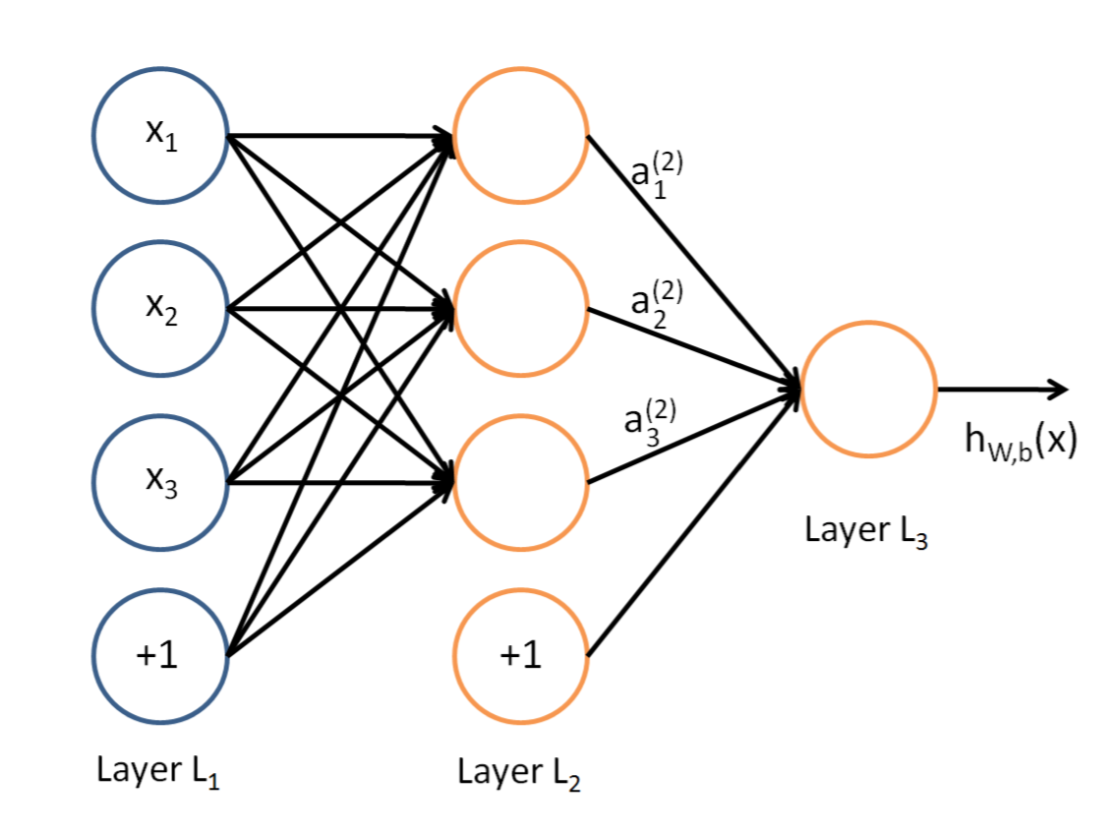
这是典型的三层神经网络的基本构成,Layer L1是输入层,Layer L2是隐含层,Layer L3是隐含层,我们现在手里有一堆数据{x1,x2,x3,…,xn},输出也是一堆数据{y1,y2,y3,…,yn},现在要他们在隐含层做某种变换,让你把数据灌进去后得到你期望的输出。如果你希望你的输出和原始输入一样,那么就是最常见的自编码模型(Auto-Encoder)。可能有人会问,为什么要输入输出都一样呢?有什么用啊?其实应用挺广的,在图像识别,文本分类等等都会用到,我会专门再写一篇Auto-Encoder的文章来说明,包括一些变种之类的。如果你的输出和原始输入不一样,那么就是很常见的人工神经网络了,相当于让原始数据通过一个映射来得到我们想要的输出数据,也就是我们今天要讲的话题。
本文直接举一个例子,带入数值演示反向传播法的过程,公式的推导等到下次写Auto-Encoder的时候再写,其实也很简单,感兴趣的同学可以自己推导下试试:)(注:本文假设你已经懂得基本的神经网络构成,如果完全不懂,可以参考Poll写的笔记:[Mechine Learning & Algorithm] 神经网络基础)
假设,你有这样一个网络层:
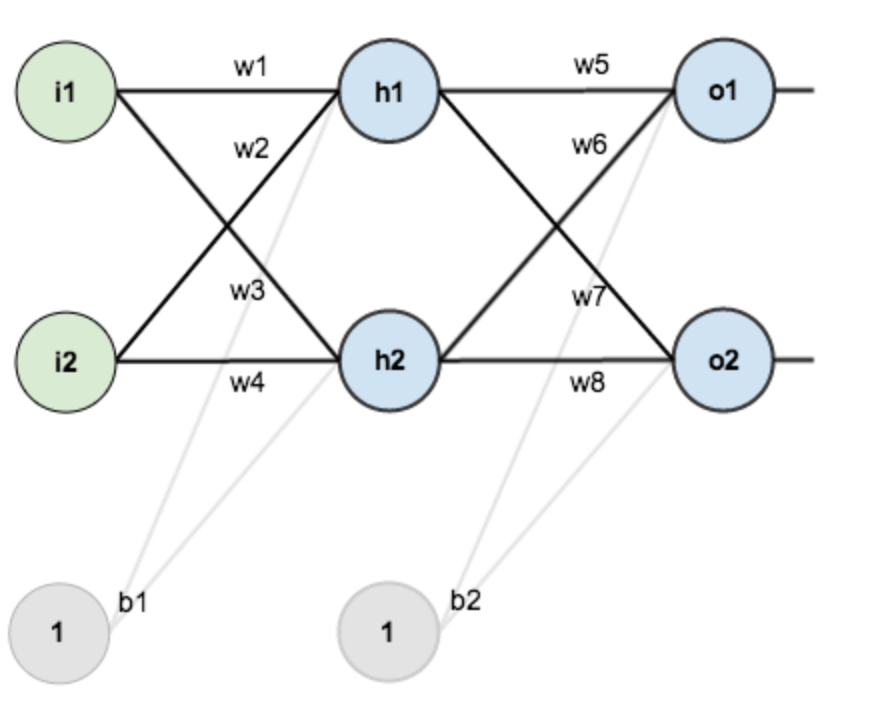
第一层是输入层,包含两个神经元i1,i2,和截距项b1;第二层是隐含层,包含两个神经元h1,h2和截距项b2,第三层是输出o1,o2,每条线上标的wi是层与层之间连接的权重,激活函数我们默认为sigmoid函数。
现在对他们赋上初值,如下图:
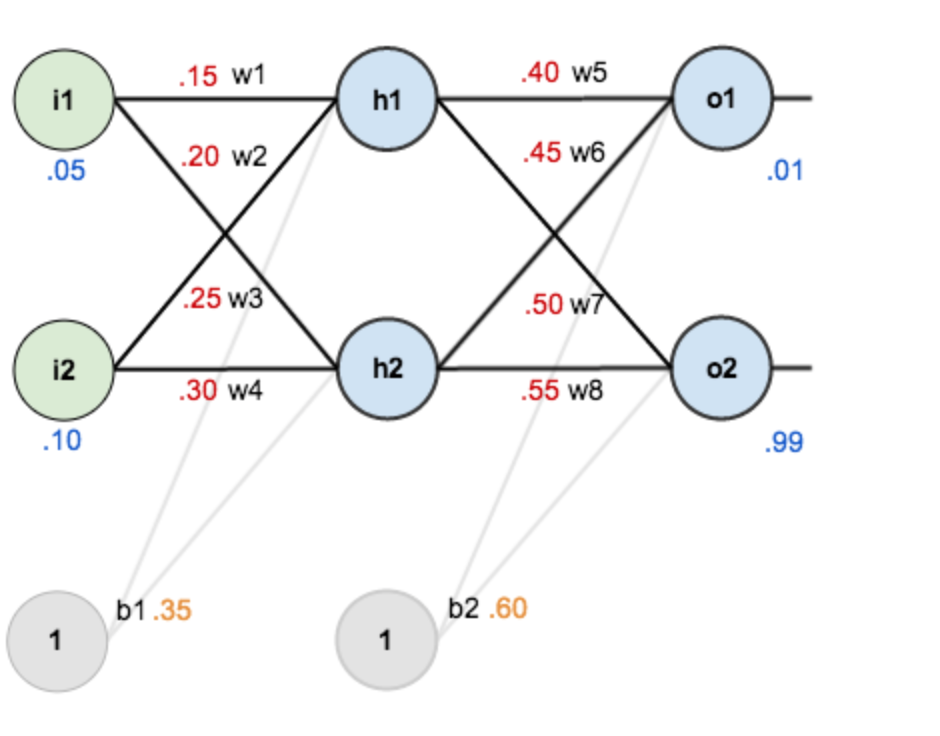
其中,输入数据 i1=0.05,i2=0.10;
输出数据 o1=0.01,o2=0.99;
初始权重 w1=0.15,w2=0.20,w3=0.25,w4=0.30;
w5=0.40,w6=0.45,w7=0.50,w8=0.55
目标:给出输入数据i1,i2(0.05和0.10),使输出尽可能与原始输出o1,o2(0.01和0.99)接近。
Step 1 前向传播
1.输入层—->隐含层:
计算神经元h1的输入加权和:
$$
\begin{array}{l}
n e t_{h 1}=w_{1} * i_{1}+w_{2} * i_{2}+b_{1} * 1 \
{ net }_{h 1}=0.15 * 0.05+0.2 * 0.1+0.35 * 1=0.3775
\end{array}
$$
神经元h1的输出o1:(此处用到激活函数为sigmoid函数):
$$
{ out }_{h 1}=\frac{1}{1+e^{-n e t_{h 1}}}=\frac{1}{1+e^{-0.3775}}=0.593269992
$$
同理,可计算出神经元h2的输出o2:
$$
{ out }_{h 2}=0.596884378
$$
2.隐含层—->输出层:
计算输出层神经元o1和o2的值:
$$
\begin{array}{l}
{ net }{o 1}=w{5} * { out }{h 1}+w{6} * { out }{h 2}+b{2} * 1 \
{ net }{o 1}=0.4 * 0.593269992+0.45 * 0.596884378+0.6 * 1=1.105905967 \
{ out }{o 1}=\frac{1}{1+e^{-n e t_{o 1}}}=\frac{1}{1+e^{-1.105905967}}=0.75136507 \
{ out }_{o 2}=0.772928465
\end{array}
$$
这样前向传播的过程就结束了,我们得到输出值为[0.75136079 , 0.772928465],与实际值[0.01 , 0.99]相差还很远,现在我们对误差进行反向传播,更新权值,重新计算输出。
Step 2 反向传播
1.计算总误差
总误差:(square error)
$$
E_{ {total }}=\sum \frac{1}{2}( { target }- { output })^{2}
$$
但是有两个输出,所以分别计算o1和o2的误差,总误差为两者之和:
$$
\begin{array}{l}
E_{o 1}=\frac{1}{2}\left( { target }_{o 1}- { out }_{o 1}\right)^{2}=\frac{1}{2}(0.01-0.75136507)^{2}=0.274811083 \
E_{o 2}=0.023560026 \
E_{ {total }}=E_{o 1}+E_{o 2}=0.274811083+0.023560026=0.298371109
\end{array}
$$
2.隐含层—->输出层的权值更新:
以权重参数w5为例,如果我们想知道w5对整体误差产生了多少影响,可以用整体误差对w5求偏导求出:(链式法则) $$ \frac{\partial E_{{total }}}{\partial w_{5}}=\frac{\partial E_{\text {total }}}{\partial { out }_{o 1}} * \frac{\partial {out }_{o 1}}{\partial { net }_{o 1}} * \frac{\partial { net }_{o 1}}{\partial w_{5}} $$ 下面的图可以更直观的看清楚误差是怎样反向传播的:
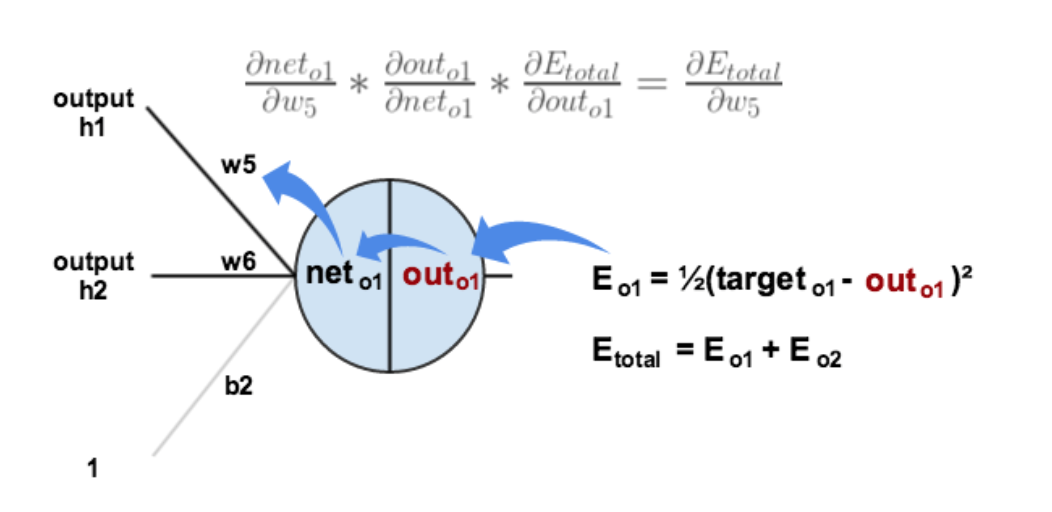
现在我们来分别计算每个式子的值:
计算: $$ \frac{\partial E_{ {total }}}{\partial { out }_{o 1}} $$
$$
\begin{array}{l}
E_{ {total }}=\frac{1}{2}\left( { target }_{o 1}-\text { out }_{o 1}\right)^{2}+\frac{1}{2}\left( { target }_{o 2}- { out }_{o 2}\right)^{2} \
\frac{\partial E_{ {total }}}{\partial { out }_{o 1}}=2 * \frac{1}{2}\left( { target }_{o 1}- { out }_{o 1}\right)^{2-1} *-1+0 \
\frac{\partial E_{ {total }}}{\partial { outo }}=-\left( { target }_{o 1}- { out }_{o 1}\right)=-(0.01-0.75136507)=0.74136507
\end{array}
$$
计算: $$ \frac{\partial { out }{o 1}}{\partial n e t{o 1}} $$
$$
\begin{array}{l}
{ out }{o 1}=\frac{1}{1+e^{-n e t{o 1}}} \
\frac{\partial { out }{o 1}}{\partial { net }{o 1}}= { out }{o 1}\left(1- { out }{o 1}\right)=0.75136507(1-0.75136507)=0.186815602
\end{array}
$$
(这一步实际上就是对sigmoid函数求导,比较简单,可以自己推导一下)
计算: $$ \frac{\partial { net }{o 1}}{\partial w{5}} $$
$$
\begin{array}{l}
n e t_{o 1}=w_{5} * { out }_{h 1}+w_{6} * { out }_{h 2}+b_{2} * 1 \
\frac{\partial { net }_{o 1}}{\partial w_{5}}=1 * { out }_{h 1} * w_{5}^{(1-1)}+0+0= { out }_{h 1}=0.593269992
\end{array}
$$
最后三者相乘:
$$
\begin{array}{l}
\frac{\partial E_{ {total }}}{\partial w_{5}}=\frac{\partial E_{ {total }}}{\partial o u t_{o 1}} * \frac{\partial { out }_{o 1}}{\partial n e t_{o 1}} * \frac{\partial n e t_{o 1}}{\partial w_{5}} \
\frac{\partial E_{ {total }}}{\partial w_{5}}=0.74136507 * 0.186815602 * 0.593269992=0.082167041
\end{array}
$$
这样我们就计算出整体误差E(total)对w5的偏导值。
回过头来再看看上面的公式,我们发现:
$$
\frac{\partial E_{t o t a l}}{\partial w_{5}}=-\left(\operatorname{target}_{o 1}- { out }_{o 1}\right) * { out }_{o 1}\left(1- { out }_{o 1}\right) * { out }_{h 1}
$$
为了表达方便,用$$\delta_{o 1}$$来表示输出层的误差:
$$
\begin{array}{l}
\delta_{o 1}=\frac{\partial E_{ {total }}}{\partial o u t_{o 1}} * \frac{\partial { out }_{o 1}}{\partial n e t_{o 1}}=\frac{\partial E_{ {total }}}{\partial n e t_{o 1}} \
\delta_{o 1}=-\left(\operatorname{target}_{o 1}- { out }_{o 1}\right) * { out }_{o 1}\left(1- { out }_{o 1}\right)
\end{array}
$$
因此,整体误差E(total)对w5的偏导公式可以写成:
$$
\frac{\partial E_{ {total }}}{\partial w_{5}}=\delta_{o 1} { out }_{h 1}
$$
如果输出层误差计为负的话,也可以写成:
$$
\frac{\partial E_{ {total }}}{\partial w_{5}}=-\delta_{o 1} { out }_{h 1}
$$
最后我们来更新w5的值:
$$
w_{5}^{+}=w_{5}-\eta * \frac{\partial E_{ {total }}}{\partial_{w_{5}}}=0.4-0.5 * 0.082167041=0.35891648
$$
(其中,$$\eta$$是学习速率,这里我们取0.5)
同理,可更新w6,w7,w8:
$$
\begin{array}{l}
w_{6}^{+}=0.408666186 \
w_{7}^{+}=0.511301270 \
w_{8}^{+}=0.561370121
\end{array}
$$
3.隐含层—->输入层的权值更新:
方法其实与上面说的差不多,但是有个地方需要变一下,在上文计算总误差对w5的偏导时,是从out(o1)—->net(o1)—->w5,但是在隐含层之间的权值更新时,是out(h1)—->net(h1)—->w1,而out(h1)会接受E(o1)和E(o2)两个地方传来的误差,所以这个地方两个都要计算。
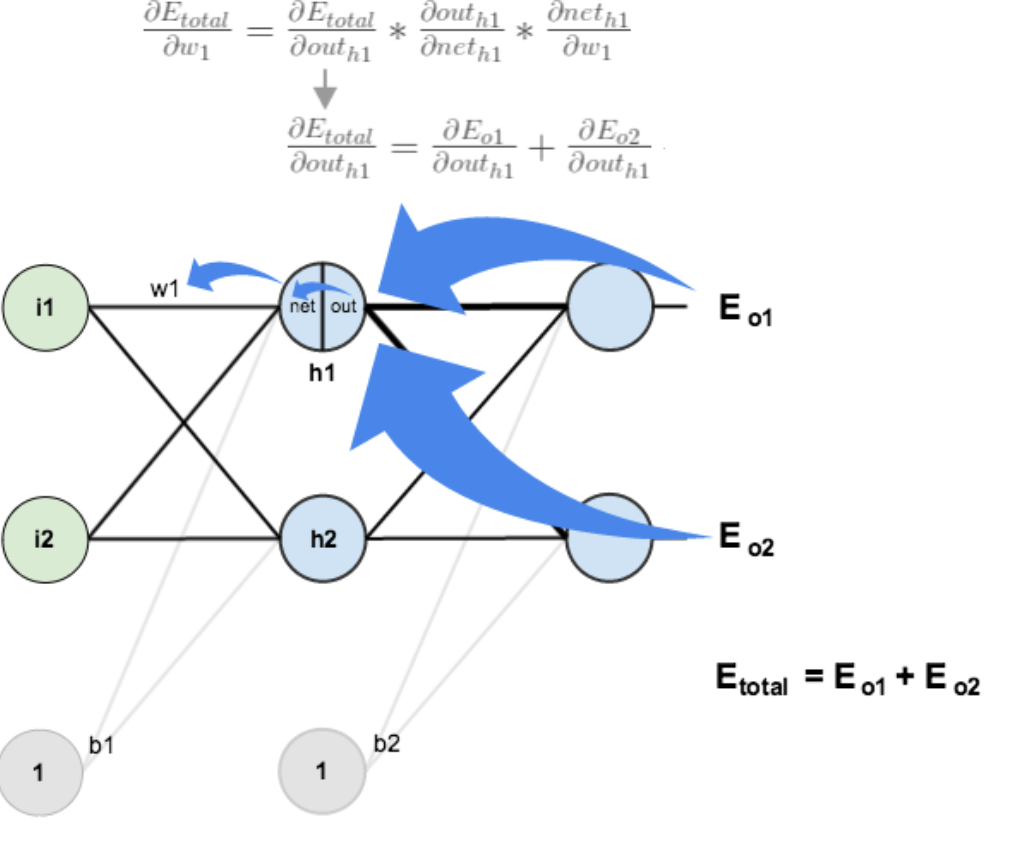
计算: $$ \frac{\partial E_{ {total }}}{\partial { out }_{h 1}} $$
$$ \frac{\partial E_{ {total }}}{\partial o u t_{h 1}}=\frac{\partial E_{o 1}}{\partial o u t_{h 1}}+\frac{\partial E_{o 2}}{\partial o u t_{h 1}} $$
先计算: $$ \frac{\partial E_{o 1}}{\partial o u t_{h 1}} $$
$$
\begin{array}{l}
\frac{\partial E_{o 1}}{\partial o u t_{h 1}}=\frac{\partial E_{o 1}}{\partial n e t_{o 1}} * \frac{\partial n e t_{o 1}}{\partial o u t_{h 1}} \
\frac{\partial E_{o 1}}{\partial n e t_{o 1}}=\frac{\partial E_{o 1}}{\partial o u t_{o 1}} * \frac{\partial o u t_{o 1}}{\partial n e t_{o 1}}=0.74136507 * 0.186815602=0.138498562 \
{ net }_{o 1}=w_{5} * o u t_{h 1}+w_{6} * { out }_{h 2}+b_{2} * 1 \
\frac{\partial { net }_{o 1}}{\partial o u t_{h 1}}=w_{5}=0.40 \
\frac{\partial E_{o 1}}{\partial o u t_{h 1}}=\frac{\partial E_{o 1}}{\partial n e t_{o 1}} * \frac{\partial n e t_{o 1}}{\partial o u t_{h 1}}=0.138498562 * 0.40=0.055399425
\end{array}
$$
同理,计算出: $$ \frac{\partial E_{o 2}}{\partial o u t_{h 1}}=-0.019049119 $$ 两者相加得到总值: $$ \frac{\partial E_{ {total }}}{\partial o u t_{h 1}}=\frac{\partial E_{o 1}}{\partial o u t_{h 1}}+\frac{\partial E_{o 2}}{\partial o u t_{h 1}}=0.055399425+-0.019049119=0.036350306 $$ 再计算: $$ \frac{\partial o u t_{h 1}}{\partial n e t_{h 1}} $$
$$
\begin{array}{l}
{ out }{h 1}=\frac{1}{1+e^{-n e t}{h 1}} \
\frac{\partial { out }{h 1}}{\partial n e t{h 1}}= { out }{h 1}\left(1- { out }{h 1}\right)=0.59326999(1-0.59326999)=0.241300709
\end{array}
$$
再计算: $$ \frac{\partial n e t_{h 1}}{\partial w_{1}} $$
$$
\begin{array}{l}
{ net }{h 1}=w{1} * i_{1}+w_{2} * i_{2}+b_{1} * 1 \
\frac{\partial n e t_{h 1}}{\partial w_{1}}=i_{1}=0.05
\end{array}
$$
最后,三者相乘:
$$
\begin{array}{l}
\frac{\partial E_{ {total }}}{\partial w_{1}}=\frac{\partial E_{ {total }}}{\partial { out }_{h 1}} * \frac{\partial { out }_{h 1}}{\partial n e t_{h 1}} * \frac{\partial { net }_{h 1}}{\partial w_{1}} \
\frac{\partial E_{ {total }}}{\partial w_{1}}=0.036350306 * 0.241300709 * 0.05=0.000438568
\end{array}
$$
为了简化公式,用sigma(h1)表示隐含层单元h1的误差:
$$
\begin{array}{l}
\frac{\partial E_{ {total }}}{\partial w_{1}}=\left(\sum_{o} \frac{\partial E_{ {total }}}{\partial o u t_{o}} * \frac{\partial { out }_{o}}{\partial n e t_{o}} * \frac{\partial { net }_{o}}{\partial o u t_{h 1}}\right) * \frac{\partial o u t_{h 1}}{\partial n e t_{h 1}} * \frac{\partial n e t_{h 1}}{\partial w_{1}} \
\frac{\partial E_{ {total }}}{\partial w_{1}}=\left(\sum_{o} \delta_{o} * w_{h o}\right) * { out }_{h 1}\left(1- { out }_{h 1}\right) * i_{1} \
\frac{\partial E_{ {total }}}{\partial w_{1}}=\delta_{h 1} i_{1}
\end{array}
$$
最后,更新w1的权值:
$$
w_{1}^{+}=w_{1}-\eta * \frac{\partial E_{\text {total }}}{\partial w_{1}}=0.15-0.5 * 0.000438568=0.149780716
$$
同理,额可更新w2,w3,w4的权值:
$$
\begin{array}{l}
w_{2}^{+}=0.19956143 \
w_{3}^{+}=0.24975114 \
w_{4}^{+}=0.29950229
\end{array}
$$
这样误差反向传播法就完成了,最后我们再把更新的权值重新计算,不停地迭代,在这个例子中第一次迭代之后,总误差E(total)由0.298371109下降至0.291027924。迭代10000次后,总误差为0.000035085,输出为0.015912196,0.984065734,证明效果还是不错的。
#coding:utf-8
import random
import math
#
# 参数解释:
# "pd_" :偏导的前缀
# "d_" :导数的前缀
# "w_ho" :隐含层到输出层的权重系数索引
# "w_ih" :输入层到隐含层的权重系数的索引
class NeuralNetwork:
LEARNING_RATE = 0.5
def __init__(self, num_inputs, num_hidden, num_outputs, hidden_layer_weights = None, hidden_layer_bias = None, output_layer_weights = None, output_layer_bias = None):
self.num_inputs = num_inputs
self.hidden_layer = NeuronLayer(num_hidden, hidden_layer_bias)
self.output_layer = NeuronLayer(num_outputs, output_layer_bias)
self.init_weights_from_inputs_to_hidden_layer_neurons(hidden_layer_weights)
self.init_weights_from_hidden_layer_neurons_to_output_layer_neurons(output_layer_weights)
def init_weights_from_inputs_to_hidden_layer_neurons(self, hidden_layer_weights):
weight_num = 0
for h in range(len(self.hidden_layer.neurons)):
for i in range(self.num_inputs):
if not hidden_layer_weights:
self.hidden_layer.neurons[h].weights.append(random.random())
else:
self.hidden_layer.neurons[h].weights.append(hidden_layer_weights[weight_num])
weight_num += 1
def init_weights_from_hidden_layer_neurons_to_output_layer_neurons(self, output_layer_weights):
weight_num = 0
for o in range(len(self.output_layer.neurons)):
for h in range(len(self.hidden_layer.neurons)):
if not output_layer_weights:
self.output_layer.neurons[o].weights.append(random.random())
else:
self.output_layer.neurons[o].weights.append(output_layer_weights[weight_num])
weight_num += 1
def inspect(self):
print('------')
print('* Inputs: {}'.format(self.num_inputs))
print('------')
print('Hidden Layer')
self.hidden_layer.inspect()
print('------')
print('* Output Layer')
self.output_layer.inspect()
print('------')
def feed_forward(self, inputs):
hidden_layer_outputs = self.hidden_layer.feed_forward(inputs)
return self.output_layer.feed_forward(hidden_layer_outputs)
def train(self, training_inputs, training_outputs):
self.feed_forward(training_inputs)
# 1. 输出神经元的值
pd_errors_wrt_output_neuron_total_net_input = [0] * len(self.output_layer.neurons)
for o in range(len(self.output_layer.neurons)):
# ∂E/∂zⱼ
pd_errors_wrt_output_neuron_total_net_input[o] = self.output_layer.neurons[o].calculate_pd_error_wrt_total_net_input(training_outputs[o])
# 2. 隐含层神经元的值
pd_errors_wrt_hidden_neuron_total_net_input = [0] * len(self.hidden_layer.neurons)
for h in range(len(self.hidden_layer.neurons)):
# dE/dyⱼ = Σ ∂E/∂zⱼ * ∂z/∂yⱼ = Σ ∂E/∂zⱼ * wᵢⱼ
d_error_wrt_hidden_neuron_output = 0
for o in range(len(self.output_layer.neurons)):
d_error_wrt_hidden_neuron_output += pd_errors_wrt_output_neuron_total_net_input[o] * self.output_layer.neurons[o].weights[h]
# ∂E/∂zⱼ = dE/dyⱼ * ∂zⱼ/∂
pd_errors_wrt_hidden_neuron_total_net_input[h] = d_error_wrt_hidden_neuron_output * self.hidden_layer.neurons[h].calculate_pd_total_net_input_wrt_input()
# 3. 更新输出层权重系数
for o in range(len(self.output_layer.neurons)):
for w_ho in range(len(self.output_layer.neurons[o].weights)):
# ∂Eⱼ/∂wᵢⱼ = ∂E/∂zⱼ * ∂zⱼ/∂wᵢⱼ
pd_error_wrt_weight = pd_errors_wrt_output_neuron_total_net_input[o] * self.output_layer.neurons[o].calculate_pd_total_net_input_wrt_weight(w_ho)
# Δw = α * ∂Eⱼ/∂wᵢ
self.output_layer.neurons[o].weights[w_ho] -= self.LEARNING_RATE * pd_error_wrt_weight
# 4. 更新隐含层的权重系数
for h in range(len(self.hidden_layer.neurons)):
for w_ih in range(len(self.hidden_layer.neurons[h].weights)):
# ∂Eⱼ/∂wᵢ = ∂E/∂zⱼ * ∂zⱼ/∂wᵢ
pd_error_wrt_weight = pd_errors_wrt_hidden_neuron_total_net_input[h] * self.hidden_layer.neurons[h].calculate_pd_total_net_input_wrt_weight(w_ih)
# Δw = α * ∂Eⱼ/∂wᵢ
self.hidden_layer.neurons[h].weights[w_ih] -= self.LEARNING_RATE * pd_error_wrt_weight
def calculate_total_error(self, training_sets):
total_error = 0
for t in range(len(training_sets)):
training_inputs, training_outputs = training_sets[t]
self.feed_forward(training_inputs)
for o in range(len(training_outputs)):
total_error += self.output_layer.neurons[o].calculate_error(training_outputs[o])
return total_error
class NeuronLayer:
def __init__(self, num_neurons, bias):
# 同一层的神经元共享一个截距项b
self.bias = bias if bias else random.random()
self.neurons = []
for i in range(num_neurons):
self.neurons.append(Neuron(self.bias))
def inspect(self):
print('Neurons:', len(self.neurons))
for n in range(len(self.neurons)):
print(' Neuron', n)
for w in range(len(self.neurons[n].weights)):
print(' Weight:', self.neurons[n].weights[w])
print(' Bias:', self.bias)
def feed_forward(self, inputs):
outputs = []
for neuron in self.neurons:
outputs.append(neuron.calculate_output(inputs))
return outputs
def get_outputs(self):
outputs = []
for neuron in self.neurons:
outputs.append(neuron.output)
return outputs
class Neuron:
def __init__(self, bias):
self.bias = bias
self.weights = []
def calculate_output(self, inputs):
self.inputs = inputs
self.output = self.squash(self.calculate_total_net_input())
return self.output
def calculate_total_net_input(self):
total = 0
for i in range(len(self.inputs)):
total += self.inputs[i] * self.weights[i]
return total + self.bias
# 激活函数sigmoid
def squash(self, total_net_input):
return 1 / (1 + math.exp(-total_net_input))
def calculate_pd_error_wrt_total_net_input(self, target_output):
return self.calculate_pd_error_wrt_output(target_output) * self.calculate_pd_total_net_input_wrt_input();
# 每一个神经元的误差是由平方差公式计算的
def calculate_error(self, target_output):
return 0.5 * (target_output - self.output) ** 2
def calculate_pd_error_wrt_output(self, target_output):
return -(target_output - self.output)
def calculate_pd_total_net_input_wrt_input(self):
return self.output * (1 - self.output)
def calculate_pd_total_net_input_wrt_weight(self, index):
return self.inputs[index]
# 文中的例子:
nn = NeuralNetwork(2, 2, 2, hidden_layer_weights=[0.15, 0.2, 0.25, 0.3], hidden_layer_bias=0.35, output_layer_weights=[0.4, 0.45, 0.5, 0.55], output_layer_bias=0.6)
for i in range(10000):
nn.train([0.05, 0.1], [0.01, 0.09])
print(i, round(nn.calculate_total_error([[[0.05, 0.1], [0.01, 0.09]]]), 9))
#另外一个例子,可以把上面的例子注释掉再运行一下:
# training_sets = [
# [[0, 0], [0]],
# [[0, 1], [1]],
# [[1, 0], [1]],
# [[1, 1], [0]]
# ]
# nn = NeuralNetwork(len(training_sets[0][0]), 5, len(training_sets[0][1]))
# for i in range(10000):
# training_inputs, training_outputs = random.choice(training_sets)
# nn.train(training_inputs, training_outputs)
# print(i, nn.calculate_total_error(training_sets))
最后写到这里就结束了,现在还不会用latex编辑数学公式,本来都直接想写在草稿纸上然后扫描了传上来,但是觉得太影响阅读体验了。以后会用公式编辑器后再重把公式重新编辑一遍。稳重使用的是sigmoid激活函数,实际还有几种不同的激活函数可以选择,具体的可以参考文献[3],最后推荐一个在线演示神经网络变化的网址:http://www.emergentmind.com/neural-network,可以自己填输入输出,然后观看每一次迭代权值的变化,很好玩~如果有错误的或者不懂的欢迎留言:)


评论